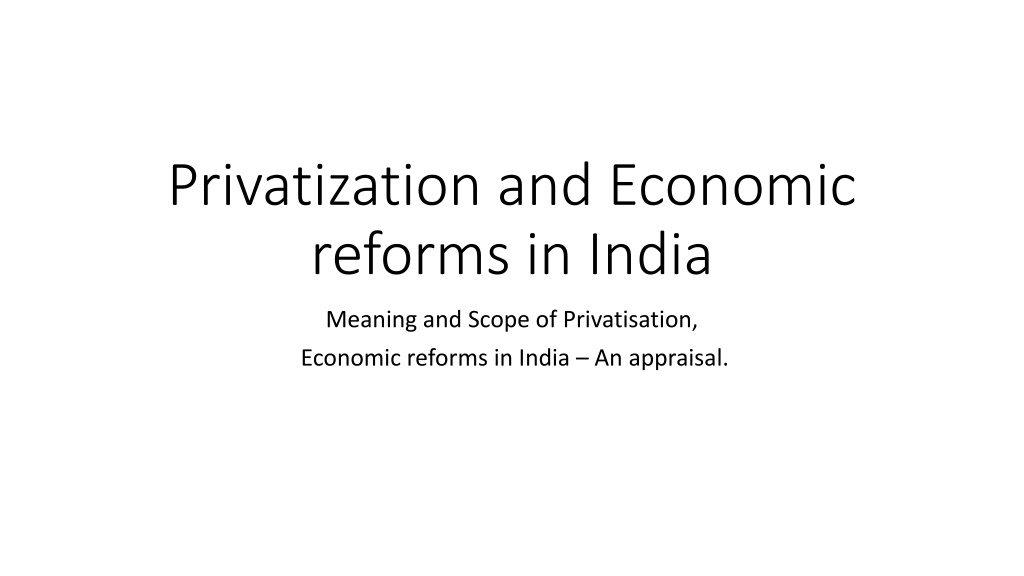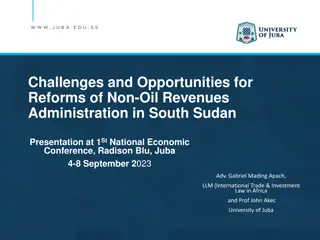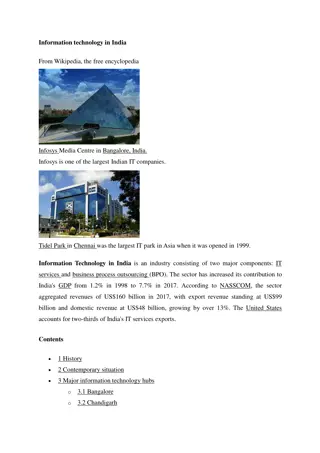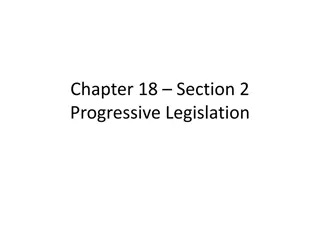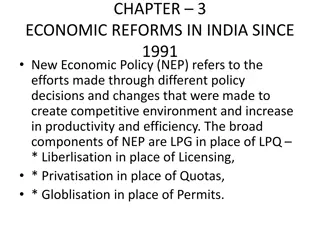Privatization and Economic Reforms in India: A Comprehensive Overview
Privatization in India involves introducing private ownership and management in publicly owned enterprises, aiming to enhance efficiency, professionalism, and competitiveness. This process includes transferring ownership to the private sector and selling equity in public sector undertakings. The government has implemented measures like Navaratnas and Miniratnas to improve autonomy and decision-making in select PSUs. Objectives of privatization include financial improvement, fund-raising, efficiency enhancement, and enhancing consumer services. Proponents argue that privatization reduces budget deficits, fosters competition, and improves managerial efficiency, leading to profit-oriented decisions and increased investment opportunities. Conversely, critics point out concerns about profit motives, inequitable economic development, concentrated economic power, and potential rises in unemployment levels.
Download Presentation

Please find below an Image/Link to download the presentation.
The content on the website is provided AS IS for your information and personal use only. It may not be sold, licensed, or shared on other websites without obtaining consent from the author. Download presentation by click this link. If you encounter any issues during the download, it is possible that the publisher has removed the file from their server.
E N D
Presentation Transcript
Privatization and Economic reforms in India Meaning and Scope of Privatisation, Economic reforms in India An appraisal.
Meaning of Privatization Privatization means 1. Introduction of private ownership in publicly owned and managed enterprises 2. Introduction of private control and management in public sector undertakings 3. It implies greater role of the private sector in the economic activities of a country
Privatization can be done in two ways: 1. Transfer of ownership and management of public sector companies from the government to the private sector. 2. Privatization of public sector undertakings (PSUs) by selling off part of the equity of PSUs to the public. This process is called disinvestment
Navaratnas and Miniratnas In order to improve efficiency, infuse professionalism and enable enable PSUs to compete more effectively in the liberalized global environment, the government chose nine PSUs (BHEL, BPCL, SAIL etc.) and declared them Navaratnas . They were given greater managerial and operational autonomy in taking various decisions to run the company efficiently and to increase their profit Another 97 other profit-making enterprises were granted operational, managerial and financial autonomy and they were referred as Miniratnas
Objectives of privatization 1. Improve the financial condition of the government 2. Raising funds through disinvestment 3. Reducing the workload of public sector 4. Raising the efficiency of government undertakings 5. Providing better goods and services to the consumers 6. Bringing healthy competition within the country 7. Fixing responsibility is easier
Arguments in favor of privatization 1. Reduction in budget deficit 2. Competitive environment 3. Better in managerial efficiency 4. Profit oriented decision 5. Increase in investment and employment opportunities
Arguments against privatization 1. Profit is the main motive of privatization 2. Lope sided economic development 3. Concentration of economic power 4. Rise in level of unemployment
Methods of privatization 1. Initial Public Offering (IPO) Under this method, the share of public sector undertakings (PSUs) are sold to the retail investors and institutions. The main advantages of IPO are the follows. a. It ensures wide participation of retail investors and thus helps in a broad -based control of the public sector at the same time as it helps in the widening and deepening of the capital market b. It is likely to face less resistance from the PSU employees as there is a continuity in management
c. It can be used to offer shares to the employees d. It can be employed usefully in those cases where the government wants to raise resources but doesn t want to lose control of the enterprise. In 1990s, OECD (Organization of Economic Co-operation and Development)countries raised as much as two-thirds of all their privatization proceeds through IPOs.
2. Strategic Sale: In this method, the government sells its share in the PSU to a strategic partner. As a result, the management passes over to the buyer. The advantages for this method are as follows: a. The performance and efficiency of the management is expected to improve b. The government may realize a better price as the strategic partner may be willing to pay more c. The strategic partner may be willing to inject ore capital into PSU
d. Loss making PSUs will be unattractive to the public whereas a strategic acquirer can have the skill to turn around the business even after paying a reasonable price. Disadvantages: a. This method is unfair as many ordinary citizens can not participate in it. b. The whole process of selecting strategic partner is nontransparent and arbitrary c. Its very difficult to assess the actual value of the enterprise
d. There is a serious risk of employees losing their job as the strategic partner is likely to restructure the PSU business to align with the existing business 3. Sale to Foreigners: This a is a variant of strategic sales method where the buyer is not a domestic company but a foreign company. In small countries, where the domestic private capital is limited, government sells its stakes to foreign companies. It s expected that foreign companies will bring world class technology to and expertise to run the PSU.
4. Management Employees buyouts: In this route to privatization, management, employees themselves buy major stakes in their firms. The advantage of this method is that it is easy to implement both politically and technically. This method is widely used in Croatia, Poland, Romania, and Slovenia One important disadvantage is that benefits are unevenly distributed: employees in good firms get valuable assets in those in money losers get almost nothing
The second disadvantage is government tends to charge low prices to insiders and thus realize little revenue Finally, Managers and insiders may connive to block the entry of outsiders 5. Equal-Access Voucher Programme: This form of privatization involves distribution of vouchers across the population and attempts to allocate assets approximately evenly among the voucher holders
Such programs excel in speed and fairness. However, they raise no revenue for the government and have unclear implications for corporate governance. Mongolia, Lithuania, Romania etc. followed this method of privatization
Different types of companies in India Private ltd company: A private limited company is a voluntary association of not less than 50 people (members), whose liability is limited, and who is not allowed to invite the general public to subscribe to its shares and debentures. Features: 1. Members 2-50 2. It has a minimum paid up capital of 1 lakh 3. Has to use the word private ltd 4. Can t borrow money from public 5. The shares allotted among members are not transferable
6. It continues even if members die 7. The liability of members is limited 8. It need not obtain a certificate for commencement of business. e.g Bajaj Tele films, Online shopping websites etc. Public Ltd Company: 1. Members 7 or more 2. It has a separate legal existence 3. All the activities have to be governed by the company act
4. Company collects its capital by selling shares 5. Members liability is limited 6. Shareholders of the company do not have any right over the working of the company Shares are freely transferable e.g., Asian paints, Apollo tires, Maruti Suzuki etc.
Government/Departmental Undertakings: 1. They are directly controlled by the government 2. No need to be registered under company s act 3. They can t use their profit to meet the expenditures without government s permission 4. Employees the government servants 5. They are directly audited by CGI 6. RTI applies
PSU Company: 1. It is a company where government holds not less than 51% share capital. e.g., ONGC, SAIL 2. Managed by board of directors 3. Board members are chosen by share holders and most of them by government 4. For the use of profit, BOG s permission is needed 5. Audited by C.As appointed by CGA 6. RTI applies
Public Corporations: 1. Established by special Act of the parliament 2. The act decides how they will run 3. Fully financed by the government but can borrow in the form of shares and bonds 4. Government appoints board of directors 5. They can use their profit without government s approval 6. Employees are not government servants 7. Audited by CAG and RTI applies
Economic Reforms in India:1991 The center of economic reforms in India which was initiated to take the country out of the economic difficulty are Liberalization, Privatization and Globalization. A. liberalization: It means to unshackle the economy from the bureaucratic cobweb to make it more competitive. Before 1991, the government had too many types of controls on the economy.
They were 1. Industrial Licensing system 2. Foreign exchange control 3. Price control on goods 4. Import License Due to the above restrictions, entrepreneurs were not willing to to set up new industries because of which the economic growth rate slowed down. Economic reforms were introduced to reduce restrictions imposed on the economy.
They were as follows: 1. Independent determination of interest rate 2. Increase in the investment limit of the small -scale industries 3. Freedom to import capital goods 4. Freedom to import technical knowhow 5. Freedom for expansion and establishment of industries 6. Freedom from Monopolies Act (MRTP Act) i.e, Monopolies and Restrictive Trade Practices 7. Removal of Industrial Licensing and registration
Globalization Globalization means integrating the economy with the rest of the world. Its main features are: 1. Free flow of goods and services 2. Free flow of capital 3. Free flow of information and technology 4. Free movement of people across the countries 5. The same conflict solving techniques for al the countries
